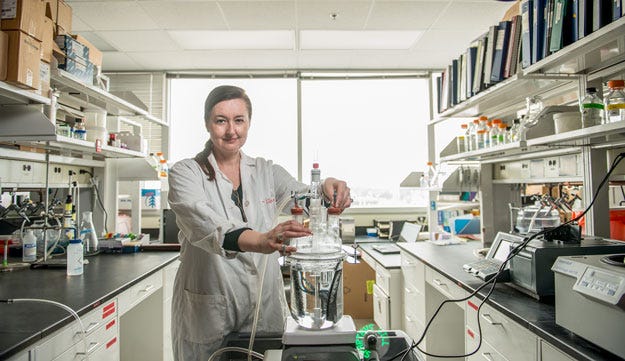March 28, 2016
A new microbial protein fiber discovered by researchers at Michigan State University contains unique properties that can transport charges at speeds of 1 billion electrons per second.
Kristopher Sturgis

The discovery came from a group study of a specific bacteria called Geobacter, a name of Latin origin that translates to "battery from earth." These bacteria contain a remarkable ability to respire minerals, meaning they breathe rust. Gemma Reguera, associate professor of microbiology and molecular genetics at the university and lead author of the research, says that studying this bacteria is what led to their rather unique discovery.
"We identified hair-like filaments produced by this bacterium that was needed to access and respire the minerals," Reguera said. "Later, we demonstrated that the filaments were binding and mineralizing uranium as well. The study published in Scientific Reports purified the filaments and demonstrated that they are made of protein and conduct electrons at high speeds of 1 billion electrons per second."
The fibers themselves are actually hair-like protein filaments known as "pili" and are only two nanometers in diameter, which Reguera says makes them ideal for integrating them into nanoelectronic devices. Her group also found that they are made of a single peptide subunit, which is assembled to form a conductive nanotube.
"The simple design, with just the same peptide component, facilitates that application of well-established genetic engineering approaches for mass-production at a reduced cost and functionalization to develop nanowires with custom-made properties," she says. For example, we can capitalize on the natural ability of the nanowires to bind uranium and develop nanowire-based sensors for this radionuclide. We can modify the metal-binding pockets that naturally bind uranium to enable the detection of other metals, and many more applications are possible."
The concept of how the nanowires function is quite simple. Bacterial cells, like all living cells, have to breathe -- and that respiration process involves the movement of electrons out of the cell. Geobacter bacteria use protein nanowires to bind respired minerals that contain metal like iron oxides, and toxic metals like uranium. The toxins are mineralized on the surface of the nanowires, which prevent the metals from permeating the cell.
"I found it remarkable that nature has created a protein fiber that can conduct electrons so fast without the need of metals and other molecules that are typically involved in the transfer of electrons in biological systems," Reguera said. "It's been known for years that some amino acids in proteins can transport charges, but at very short distances in the nanometer range. These organic nanowires that we discovered master charge transport at micrometer distances. Thus, they are a new paradigm in protein electron transfer. Understanding this mechanism will help us manipulate the conductive properties of the nanowires to suit specific applications."
Reguera says that the team has already developed some platforms that integrate the nanowires, showing their ability to interface electrodes with various molecules. She says that will be the foundation of devices that they will be optimizing for specific applications.
"Nature is pretty creative," she says. "We are still interested in understanding how these microbes use these nanowires in nature, and whether other microbes can make the same or comparable conductive appendages. We are pretty confident we will find a diversity of nanowires out there. We will continue to explore how we can manipulate the native nanowires to integrate them in nanoelectronic devices and develop biosensors of various classes. We are also exploring the possibility of interfacing them with living tissues, and the many applications that biocompatible nanowires such as these could have in medicine."
About the Author(s)
You May Also Like


